The Effect of Drip Irrigation Quota on Biochemical Activities and Yield-Related Traits in Different Drought-Tolerant Maize Varieties
Abstract
:1. Introduction
2. Materials and Methods
2.1. Plant Materials
2.2. Experimental Site and Its Features
2.3. Experimental Design
2.4. Measurement of Biochemical and Morphological Traits
2.4.1. Grain Filling Rate
2.4.2. Hormone Content and Starch Synthesis Related Enzyme Activity in Grains
2.4.3. Sugar and Amino Acid Content in Grains
2.4.4. Yield and Its Components
2.5. Statistical Analysis
3. Results
3.1. Grain Filling Characteristics
3.2. Grain Hormone Content
3.3. Enzyme Activity Related to Starch Synthesis in Grains
3.4. Content of Multiple Amino Acids in Grains
3.5. Multiple Sugar Contents in Grains
3.6. Yield and Yield Components
3.7. Correlation Analysis
4. Discussion
5. Conclusions
Author Contributions
Funding
Institutional Review Board Statement
Data Availability Statement
Acknowledgments
Conflicts of Interest
References
- Bowen, C.; Villoria, N.B. Foreign yield shocks and domestic price variability: The case of maize in developing countries. Environ. Res. Lett. 2022, 17, 124044. [Google Scholar] [CrossRef]
- Zhao, M.Z.; Zhu, S.Z. Research on Corn Production Potential of Potential Exporting Countries of World Corn. World Agric. 2015, 9, 121–130. [Google Scholar] [CrossRef]
- Ryuhei, Y.; Lizumi, T. Climate mitigation sustains agricultural research and development expenditure returns for maize yield improvement in developing countries. Environ. Res. Lett. 2023, 18, 044026. [Google Scholar] [CrossRef]
- Li, P.; Huang, Q.; Huang, S.Z.; Leng, G.Y.; Peng, J.; Wang, H.; Zheng, X.D.; Li, Y.F.; Fang, W. Various maize yield losses and their dynamics triggered by drought thresholds based on Copula-Bayesian conditional probabilities. Agric. Water Manag. 2022, 261, 107391. [Google Scholar] [CrossRef]
- Tiziani, R.; Miras-Moreno, B.; Malacrinò, A.; Vescio, R.; Lucini, L.; Mimmo, T.; Cesco, S.; Sorgonà, A. Drought, heat, and their combination impact the root exudation patterns and rhizosphere microbiome in maize roots. Environ. Exp. Bot. 2022, 203, 105071. [Google Scholar] [CrossRef]
- Xu, C.; Bian, S.F.; Zhao, H.X.; Zhang, L.H.; Yan, W.P.; Li, Y.L.; Wang, J.P.; Zhang, Z.A. Study on Yield, Growth and Development and Leaf Physiological Characteristics of Maize under Optimized Cultivation Pattern in Semi-arid Area. Acta Agric. Boreali-Sinica 2021, 36, 105–114. [Google Scholar] [CrossRef]
- Xu, C.; Li, Q.; Zhao, H.X.; Bian, S.F.; Liu, B.; Bai, Z.Y.; Yao, B.; Wang, H.J.; Wang, J.P.; Li, Y.L.; et al. Effects of irrigation quota on growth of spring maize with drip irrigation in semi-arid region. J. Northwest A&F. Univ. (Nat. Sci. Ed.) 2019, 47, 41–51, 62. [Google Scholar] [CrossRef]
- Li, W.J.; Lvu, H.Q. Effect of agricultural meteorological disasters on the production corn in the Northeast China. Acta Agron. Sin. 2022, 48, 1537–1545. [Google Scholar] [CrossRef]
- Zhang, G.Q.; Liu, C.W.; Xiao, C.H.; Xie, R.Z.; Ming, B.; Hou, P.; Liu, G.Z.; Xua, W.J.; Shen, D.P.; Wang, K.R.; et al. Optimizing water use efficiency and economic return of super high yield spring maize under drip irrigation and plastic mulching in arid areas of China. Field Crops Res. 2017, 211, 137–146. [Google Scholar] [CrossRef]
- Ibrahim, M.M.; El-Baroudy, A.A.; Taha, A.M. Irrigation and fertigation scheduling under drip irrigation for maize crop in sandy soil. Int. Agrophys. 2016, 30, 47–55. [Google Scholar] [CrossRef]
- Chen, R.; Wang, Z.H.; Dhital, Y.P.; Zhang, X.Y. A comparative evaluation of soil preferential flow of mulched drip irrigation cotton field in Xinjiang based on dyed image variability versus fractal characteristic parameter. Agric. Water Manag. 2022, 269, 107722. [Google Scholar] [CrossRef]
- Yu, H.Y.; Han, Z.X.; Zhang, Y.S.; Duan, L.S.; Zhang, M.C.; Li, Z.H. Regulation of coronatine on the grain filling characteristics and starch synthesis in maize kernels. Acta Agron. Sin. 2019, 45, 1535–1543. [Google Scholar]
- Zhang, J.H.; Yang, H.S.; Zhang, Y.Q.; Li, C.F.; Zhang, R.F.; Tai, J.C.; Zhou, Y.C. Effects of Different Drip Irrigation Modes on Starch Accumulation and Activities of Starch Synthesis-Related Enzyme of Spring Maize Grain in Northeast China. Sci. Agric. Sinica 2022, 55, 1332–1345. [Google Scholar] [CrossRef]
- Wang, Y.P.; Liu, Y.; Lu, H.J.; Zhang, N.; Wu, C.G.; Zhang, Y.S.; Liao, Y.C.; Wu, X.X. Effect of Water Stress on Grain Filling and Hormone Changes in Grains of Summer Corn. Acta Agric. Boreali-Occident. Sin. 2014, 23, 28–32. [Google Scholar] [CrossRef]
- Zhang, X.B.; Lei, L.; Lai, J.S.; Zhao, H.M.; Song, W.B. Effects of drought stress and water recovery on physiological responses and gene expression in maize seedlings. BMC Plant Biol. 2018, 18, 68. [Google Scholar] [CrossRef]
- Yao, C.T.; Zhang, F.W.; Sun, X.; Shang, D.L.; He, F.L.; Li, X.D.; Zhang, J.W.; Jiang, X.Y. Effects of S-Abscisic Acid (S-ABA) on Seed Germination, Seedling Growth, and Asr1 Gene Expression under Drought Stress in Maize. J. Plant Growth Regul. 2019, 38, 1300–1313. [Google Scholar] [CrossRef]
- Xin, L.; Liu, J.T.; Liu, S.T.; Chen, Y.L.; Nan, Z.W.; Yuan, M.Z.; Chen, J.P. Effects of Combined Application of Straw and Organic Fertilizer on Grain Yield and Quality under Wheat Maize Rotation System. Acta Agric. Boreali-Sinica 2016, 31, 164–170. [Google Scholar] [CrossRef]
- Khan, I.; Luan, C.; Qi, W.; Wang, X.M.; Yu, B.H.; Rehman, A.; Khan, A.A.; Khan, J.; Wang, L.X. The residual impact of straw mulch and biochar amendments on grain quality and amino acid contents of rainfed maize crop. J. Plant Nutri. 2023, 46, 1283–1295. [Google Scholar] [CrossRef]
- Chen, N.N.; Ji, R.P.; Jia, Q.Y.; Feng, Y.; Mi, N.; Zhang, S.J.; Zhang, Y.S.; Yu, W.Y. Effects of drought stress at key growth on yield and grain quality of spring maize. Chin. J. Ecol. 2021, 40, 1687–1694. [Google Scholar] [CrossRef]
- Wang, X.R.; Zhang, Y.J.; Chen, G.R.; Li, Y.; Li, Y.S.; Qi, X.S. Effects of drought stress on photosynthesis, yield and quality of soybean. Agric. Res. Arid. Areas 2023, 41, 150–159. [Google Scholar] [CrossRef]
- Lṻ, L.J.; Liu, S.X.; Chen, X.Y.; Zhao, A.J.; Sun, L.J.; Li, H. Nutrient Accumulation Dynamics of Different Types of Wheat During Grain Filling Stage under Drought Stress. Acta Agric. Boreali-Sinica 2021, 36, 89–98. [Google Scholar] [CrossRef]
- Yu, H.D.; Zhang, Y.M.; Zhang, Z.Y.; Zhang, J.; Wei, Y.H.; Jia, X.T.; Wang, X.C.; Ma, X.M. Towards identification of molecular mechanism in which the overexpression of wheat cytosolic and plastid glutamine synthetases in to-bacco enhanced drought tolerance. Plant Physiol. Biochem. 2020, 151, 608–620. [Google Scholar] [CrossRef] [PubMed]
- Hu, M.Y.; Zhang, Z.B.; Xu, P.; Dong, B.D.; Li, W.Q.; Li, J.J. Relationship of water use efficiency with photoassimilate accumulation and transport in wheat under deficit irrigation. Acta Agron. Sin. 2007, 33, 1711–1719. [Google Scholar] [CrossRef]
- Shi, H.R.; Wang, B.; Yang, P.J.; Li, Y.B.; Miao, F. Differences in sugar accumulation and mobilization between sequential and non-sequential senescence wheat cultivars under natural and drought conditions. PLoS ONE 2016, 11, e0166155. [Google Scholar] [CrossRef]
- Xu, C.; Yan, W.P.; Sun, N.; Liu, X.L.; Zhao, H.X.; Tan, G.B.; Wu, Z.H.; Zhang, Z.A.; Zhang, L.H.; Bian, S.F. The Impacts of Irrigation Amount on Physiological Characteristics and Yield of Spring Maize. J. Irrig. Drain. 2021, 40, 7–14. [Google Scholar] [CrossRef]
- Zhang, L.H.; Yu, J.; Xu, C.; Yan, W.P.; Sun, N.; Tan, G.B.; Zhao, H.X.; Meng, X.M.; Bian, S.F. Comparison of Drought Resistant of Different Maize Hybrids on Two Soils. J. Nrotheast Agric. Sci. 2020, 45, 1–5. [Google Scholar] [CrossRef]
- Xu, C.; Zhang, L.H.; Zhao, H.X.; Yan, W.P.; Liu, X.L.; Sun, N.; Li, F.; Tan, G.B.; Li, Q.; Bian, S.F.; et al. Characteristics of grain formation and leaf response to light and CO2 in Semi-arid region under different cultivation patterns. Agric. Res. Arid. Areas 2022, 40, 1–10. [Google Scholar] [CrossRef]
- Fu, J.; Wang, Y.; Yang, W.B.; Wang, Y.T.; Li, B.Y.; Wang, F.H.; Wang, S.X.; Bai, T.; Yin, H.Q. Effects of alternate wetting and drying irrigation and nitrogen coupling on grain filling physiology and root physiology in rice. Acta Agron. Sin. 2022, 49, 808–820. [Google Scholar]
- Gao, G.; Clare, A.S.; Rose, C.; Caldwell, G.S. Reproductive sterility increases the capacity to exploit the green seaweed Ulva rigida for commercial applications. Algal Res. 2017, 24, 64–71. [Google Scholar] [CrossRef]
- Niu, L.Y.; Li, D.J.; Liu, C.Q.; Song, J.F.; Liu, C.J.; Chen, Y.P.; Yuan, J.H. Multivariate statistical analysis on content differences of free sugars and free amino acids in fresh-edible corns. Jiangsu J. Agr. Sci. 2020, 36, 463470. [Google Scholar] [CrossRef]
- Xu, C.; Li, Q.; Zhao, H.X.; Bian, S.F.; Liu, B.; Bai, Z.Y.; Yao, B.; Wang, H.J.; Zhang, Z.A. Effects of Irrigation Quota on Photosynthetic Characteristics, Yield, and Water Utilization of Spring Maize in Semi-Arid Region. Int. J. Agric. Biol. 2019, 22, 601–610. [Google Scholar]
- Roth, J.; Ciampitti, I.A.; Vyn, T.J. Physiological evaluations of recent drought-tolerant maize hybrids at varying stress levels. Agron. J. 2013, 105, 1129–1141. [Google Scholar] [CrossRef]
- Zhang, M.W.; Qiao, J.F.; Song, S.S.; Ma, J.; Zhang, P.P.; Li, C.; Niu, J.; Guo, H.X. Effect of Drought Stress on Grain-Filling and Physiological Properties of Summer Maize and the Exogenous Spermidine Regulation. J. Nuclear Agric. Sci. 2022, 36, 2501–2509. [Google Scholar] [CrossRef]
- Li, Y.B.; Tao, H.B.; Wang, R.N.; Zhang, P.; Wu, C.J.; Lei, M.; Zhang, X.; Wang, P. Effect of drought on ear development and yield of maize. Chin. J. Eco-Agric. 2015, 23, 383–391. [Google Scholar] [CrossRef]
- Zhang, W.Q.; Zhao, B.; Qin, A.Z.; Ning, D.F.; Sun, B.; Ding, P.F.; Liu, J.; Zang, H.T.; Liu, Z.D.; Xiao, J.F. Regulation of water use efficiency of summer maize by plant growth regulator in well-irrigation area of Huang-Huai-Hai River. Agric. Res. Arid. Areas 2019, 37, 43–48, 56. [Google Scholar] [CrossRef]
- Liang, H.Y.; Liu, D.D.; Zhang, N.; Wen, X.X.; Liu, Y.; Liao, Y.C. Effect of Water Stress on Grain Filling and Endogenous Hormone Changes in Wheat Grains of Different Genotypes. Acta Agric-Occid Sin. 2015, 24, 41–47. [Google Scholar] [CrossRef]
- Liu, X.L.; Ji, P.; Yang, H.T.; Jiang, C.J.; Liang, Z.W.; Chen, Q.Z.; Lu, F.; Chen, X.; Yang, Y.Y.; Zhang, X.B. Priming effect of exogenous ABA on heat stress tolerance in rice seedlings is associated with the upregulation of antioxidative defense capability and heat shock-related genes. Plant Growth Regul. 2022, 98, 23–38. [Google Scholar] [CrossRef]
- Cai, F.L.; Ma, X.; Wang, S.L.; Lu, L.T.; Shao, R.X.; Li, H.P.; Zhao, Y.L.; Mu, X.Y.; Zhao, X.; Li, S.Y.; et al. Effect Regulating of Nitrogen on Grain Development of Maize under Heat Stress. Acta Agric. Boreali-Sin. 2022, 37, 119–127. [Google Scholar] [CrossRef]
- Liu, Y.P.; Liang, X.G.; Shen, S.; Zhou, L.L.; Gao, Z.; Zhou, S.L. Diurnal Variation and Directivity of Photosynthetic Carbon Metabolism in Maize Hybrids under Gradient Drought Stress. Sci. Agric. Sin. 2017, 50, 2083–2092. [Google Scholar] [CrossRef]
- Xu, G.W.; Lvu, Q.; Lu, D.K.; Wang, H.Z.; Chen, M.C. Effect of Wetting and Drying Alternative Irrigation Coupling with Nitrogen Application on Root Characteristic and Grain-sink Activity. Acta Agron. Sin. 2016, 42, 1495–1505. [Google Scholar] [CrossRef]
- Xu, C.; Zhang, P.; Xu, K.Z.; Li, D.Y.; Ji, P.; Feng, Y.D.; Zhao, L.P. Effects of drought stress on leaf photosynthesis and some physiological traits in different soybean cultivars. Chin. J. Oil Crop Sci. 2013, 35, 674–679. [Google Scholar] [CrossRef]
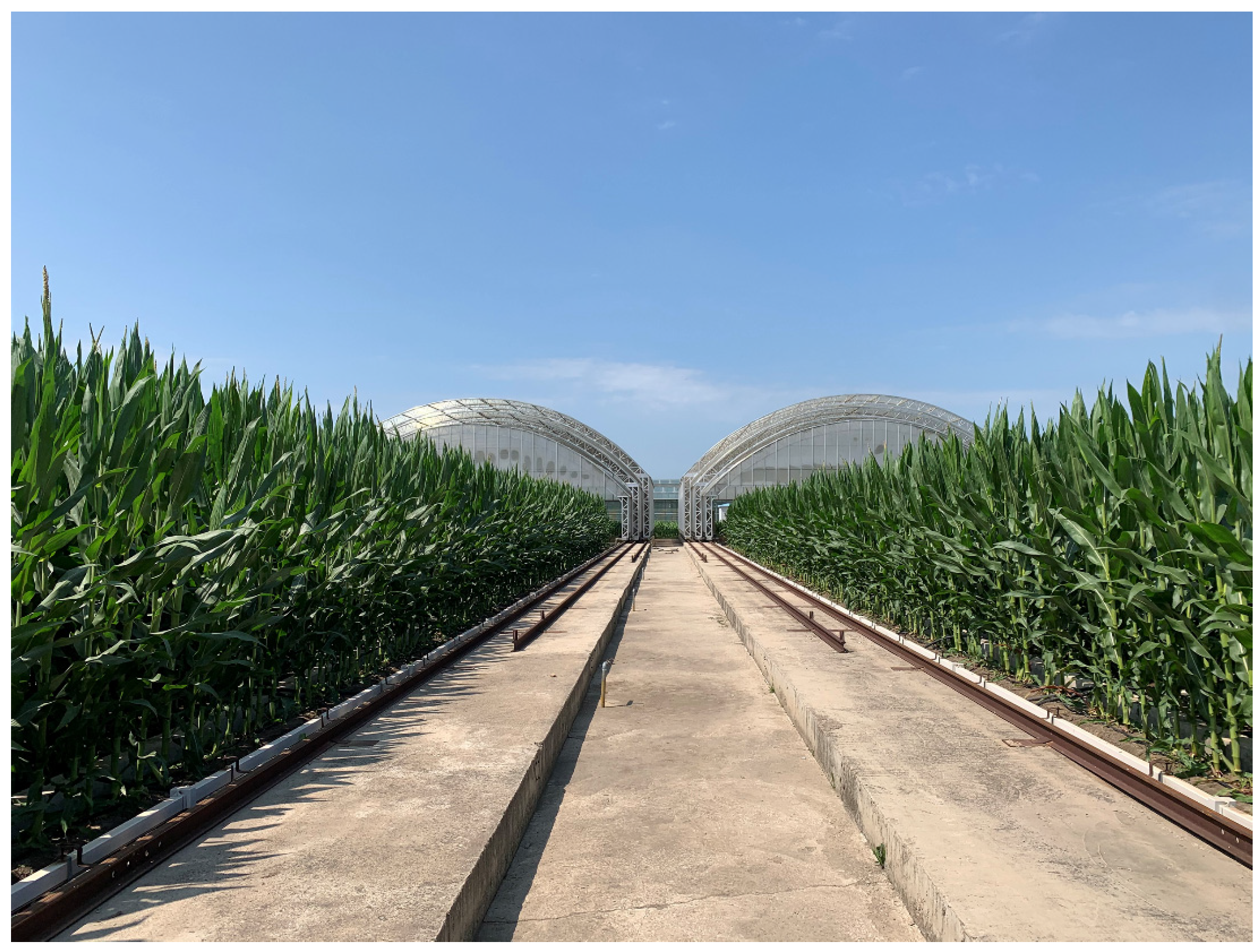

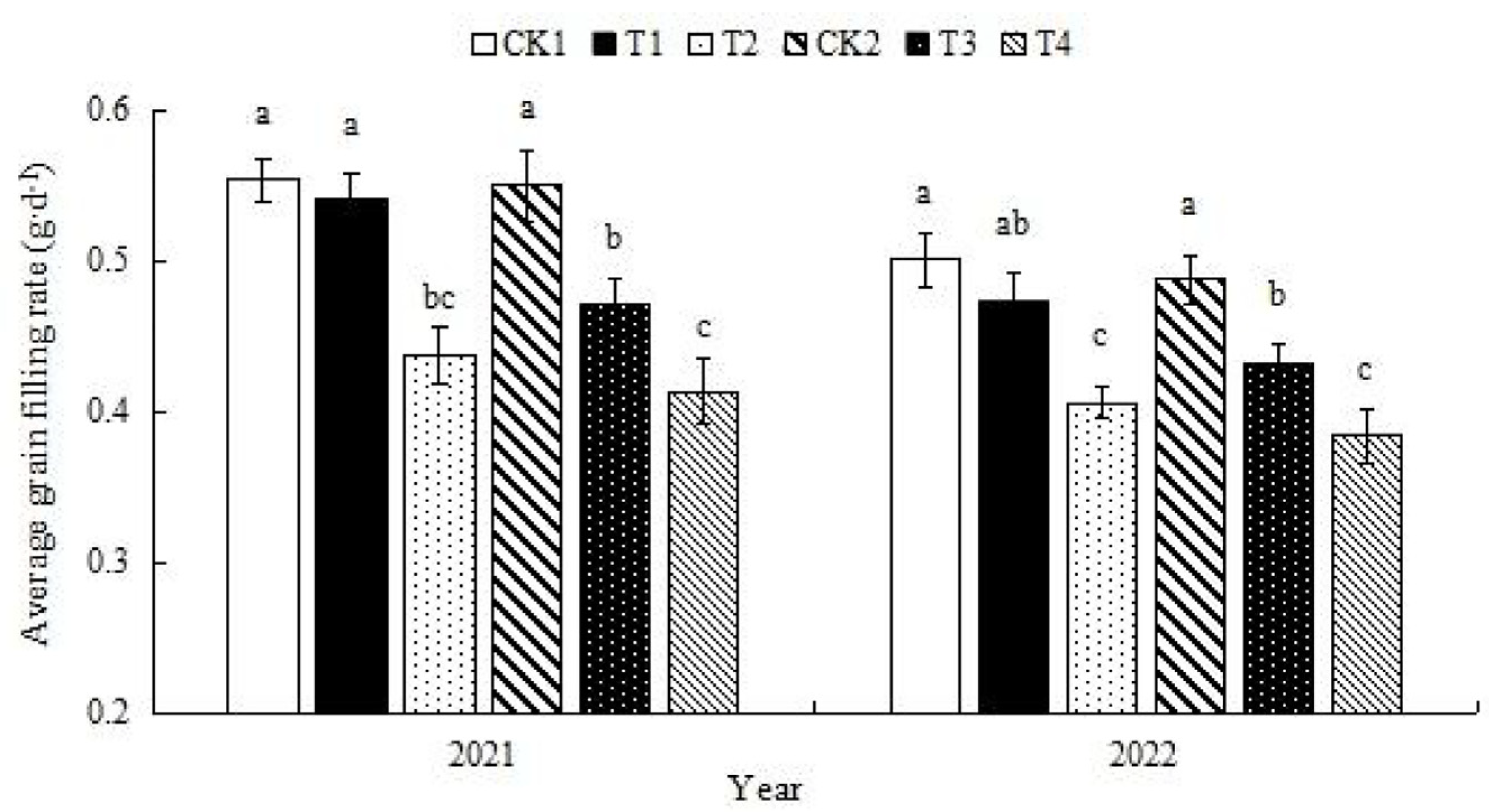
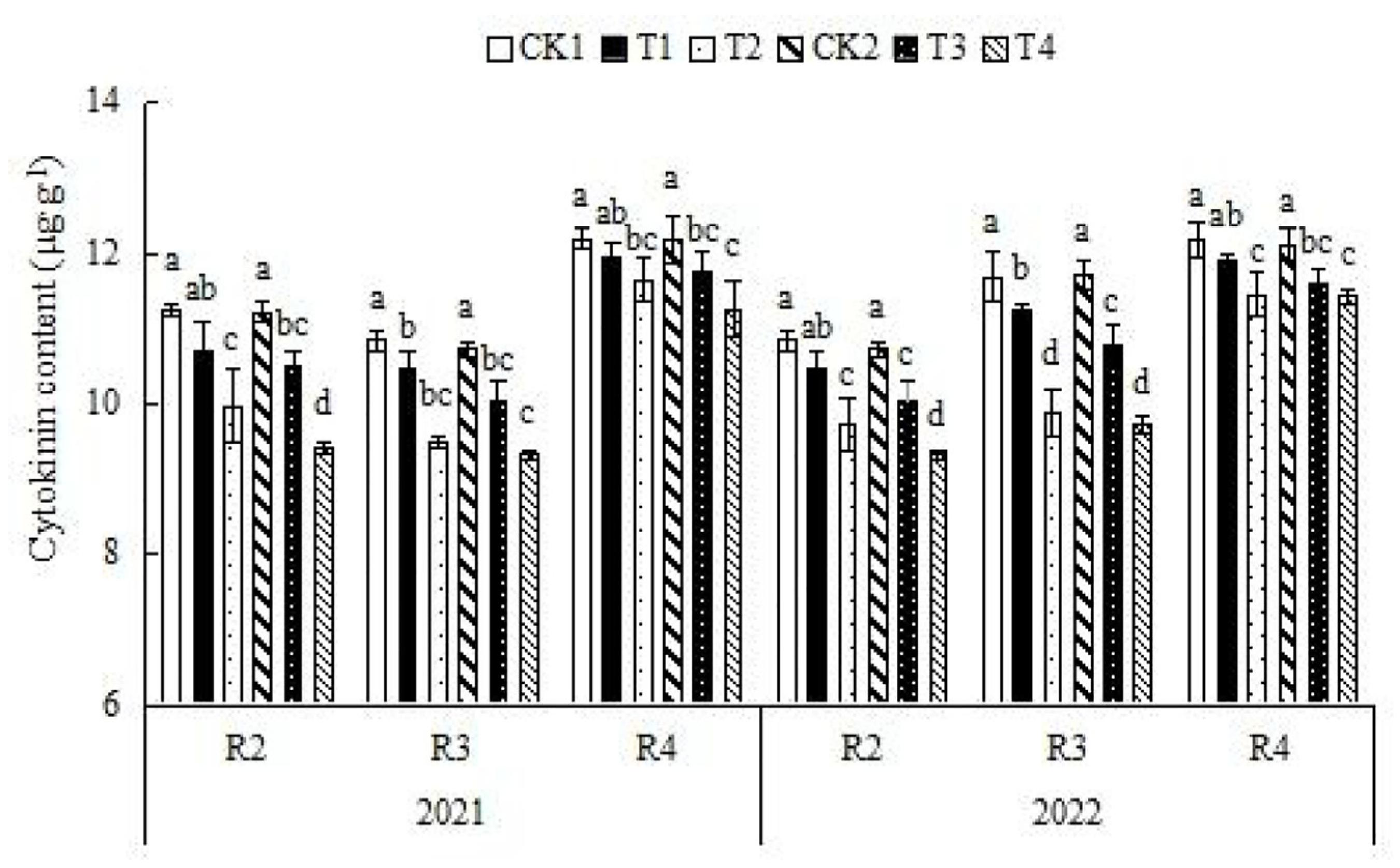


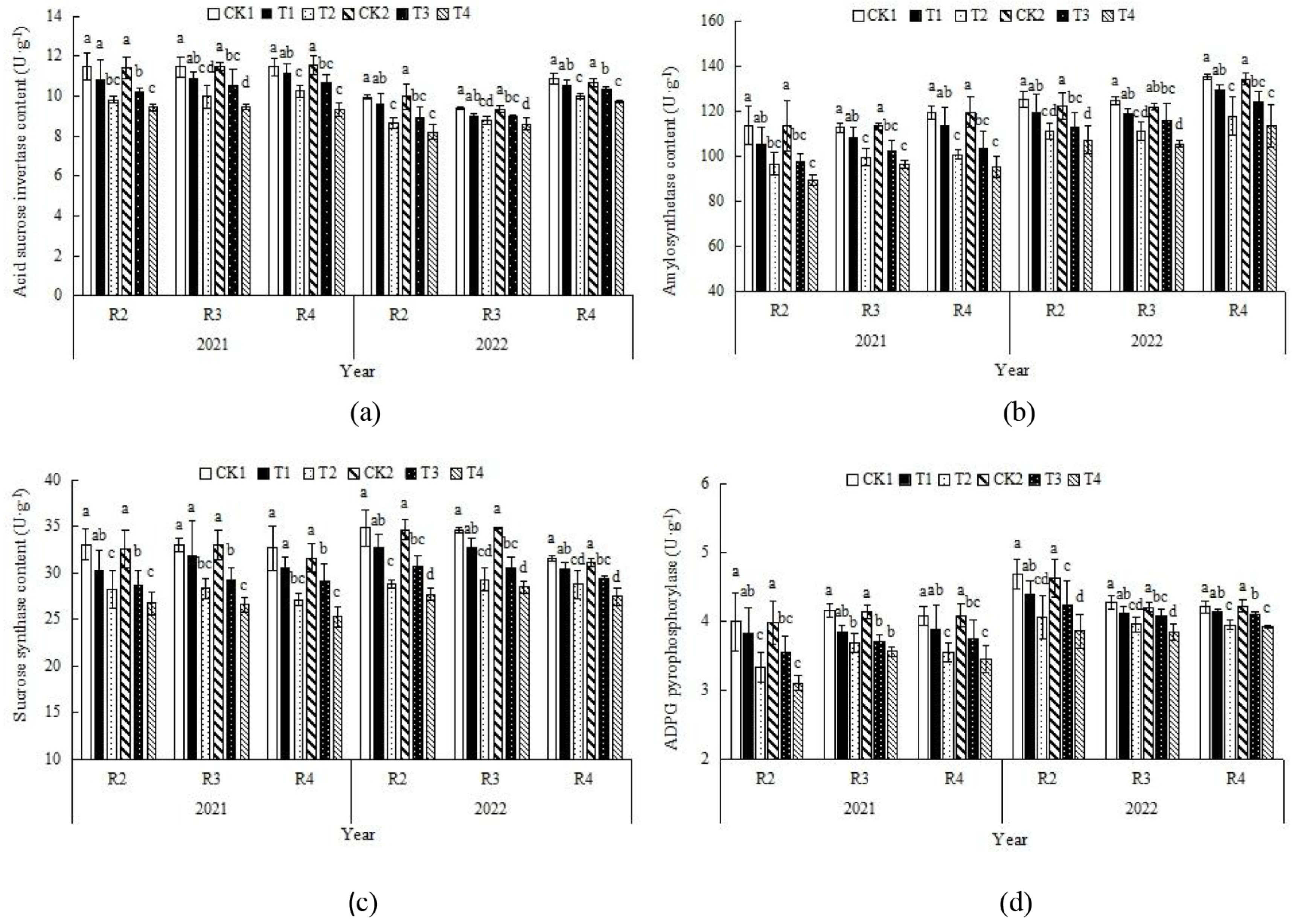
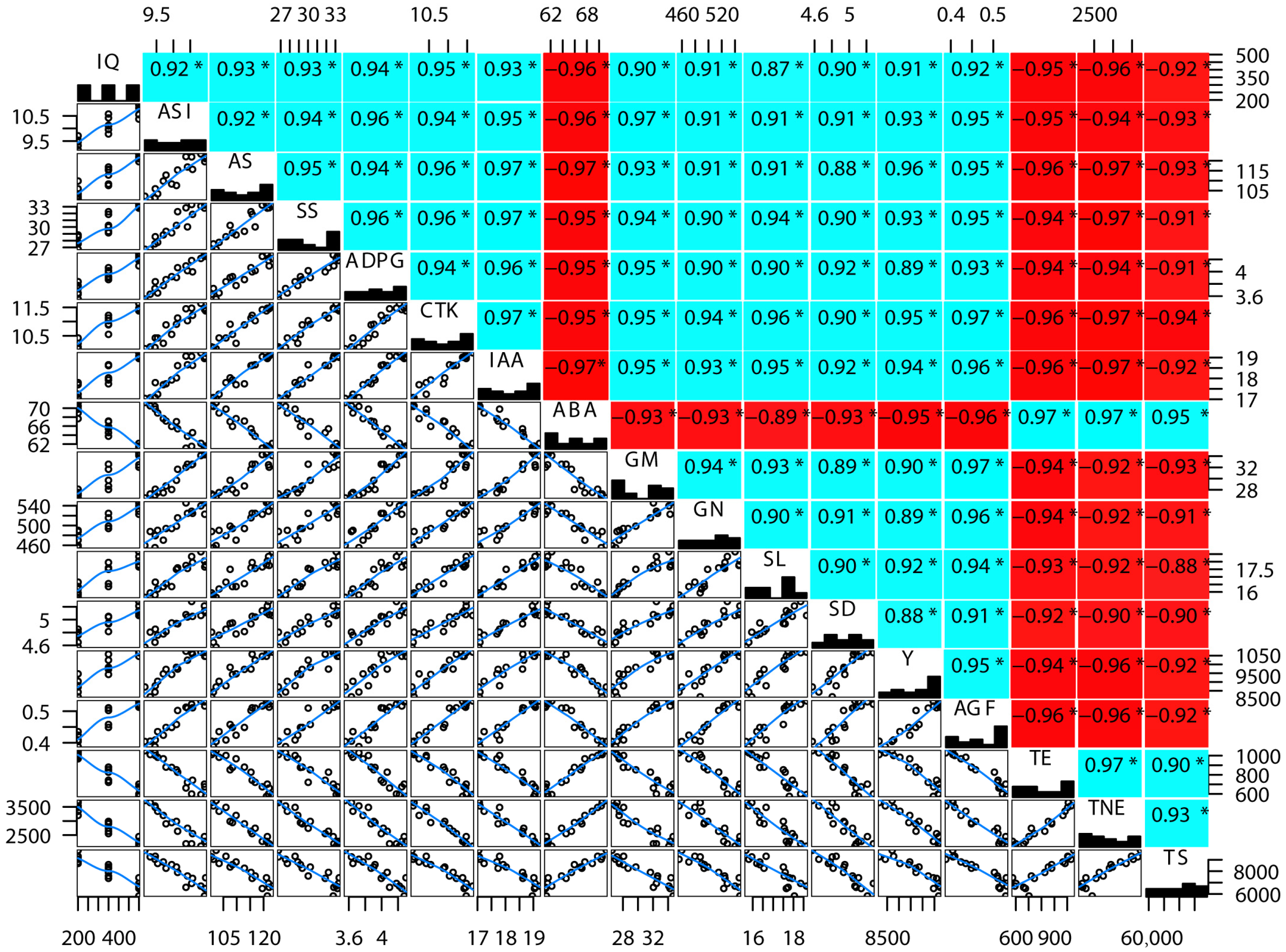
| Treatment | Varieties | Irrigation Quota (mm) |
|---|---|---|
| CK1 | XY 218 (Drought-tolerant variety) | 500 |
| T1 | 350 | |
| T2 | 200 | |
| CK2 | FM 985 (Drought-sensitive variety) | 500 |
| T3 | 350 | |
| T4 | 200 |
| Irrigation Quota (mm) | Irrigation Times | Irrigation Interval Days (d) | Single Irrigation Amount (mm) |
|---|---|---|---|
| 500 | 1st–2nd | 15 | 35 |
| 3rd–5th | 10 | 35 | |
| 6th–8th | 10 | 40 | |
| 9th–13th | 7 | 38 | |
| 14th | - | 15 | |
| 350 | 1st–2nd | 15 | 25 |
| 3rd–5th | 10 | 24 | |
| 6th–8th | 10 | 29 | |
| 9th–13th | 7 | 26 | |
| 14th | - | 11 | |
| 200 | 1st–2nd | 15 | 17 |
| 3rd–5th | 10 | 12 | |
| 6th–8th | 10 | 16 | |
| 9th–13th | 7 | 15 | |
| 14th | - | 7 |
| Year | Treatments | Times after Anthesis (d) | |||||
|---|---|---|---|---|---|---|---|
| 5 | 15 | 25 | 35 | 45 | 55 | ||
| 2021 | CK1 | 3.84 ± 0.30 a | 10.44 ± 0.21 a | 22.02 ± 0.51 a | 31.05 ± 1.83 a | 34.95 ± 0.75 a | 37.13 ± 0.28 a |
| T1 | 3.63 ± 0.31 ab | 9.71 ± 0.43 ab | 19.98 ± 0.89 b | 30.15 ± 0.18 a | 33.93 ± 0.97 a | 36.13 ± 0.30 a | |
| T2 | 3.03 ± 0.23 c | 8.47 ± 0.23 c | 17.04 ± 0.46 d | 25.98 ± 0.65 bc | 28.24 ± 0.55 c | 29.34 ± 1.03 c | |
| CK2 | 3.94 ± 0.03 a | 10.51 ± 0.37 a | 22.18 ± 0.24 a | 30.93 ± 0.51 a | 34.09 ± 0.71 a | 36.97 ± 0.52 a | |
| T3 | 3.53 ± 0.18 b | 9.19 ± 0.36 b | 18.15 ± 0.88 c | 27.59 ± 0.38 b | 30.68 ± 0.73 b | 31.81 ± 0.77 b | |
| T4 | 2.93 ± 0.15 c | 7.79 ± 0.14 d | 16.04 ± 0.55 e | 24.80 ± 0.59 c | 26.46 ± 0.60 d | 27.77 ± 0.52 d | |
| 2022 | CK1 | 3.58 ± 0.19 a | 8.63 ± 0.29 a | 19.08 ± 0.55 a | 26.22 ± 0.13 a | 30.55 ± 1.10 a | 33.70 ± 0.99 a |
| T1 | 3.32 ± 0.38 ab | 8.19 ± 0.57 a | 18.53 ± 0.32 b | 24.37 ± 0.89 ab | 28.15 ± 1.13 ab | 31.79 ± 0.79 ab | |
| T2 | 2.74 ± 0.26 c | 7.31 ± 0.47 bc | 16.46 ± 0.62 d | 22.01 ± 0.49 c | 24.98 ± 1.07 c | 27.15 ± 0.76 c | |
| CK2 | 3.54 ± 0.13 a | 8.51 ± 0.40 a | 19.28 ± 0.35 a | 26.32 ± 0.28 a | 30.46 ± 0.86 a | 32.87 ± 0.93 a | |
| T3 | 2.91 ± 0.12 bc | 7.84 ± 0.40 b | 17.75 ± 0.63 c | 22.89 ± 0.34 b | 27.10 ± 0.50 b | 28.86 ± 0.55 bc | |
| T4 | 2.56 ± 0.09 c | 6.91 ± 0.22 c | 15.92 ± 0.41 d | 20.82 ± 0.23 c | 24.01 ± 0.90 c | 25.63 ± 0.51 d | |
| Indexes | Treatments | |||||
|---|---|---|---|---|---|---|
| CK1 | T1 | T2 | CK2 | T3 | T4 | |
| Leucine content (μg∙g−1) | 108.78 e | 137.65 c | 172.49 a | 120.35 d | 156.39 b | 173.53 a |
| Valine content (μg∙g−1) | 120.40 d | 169.49 b | 203.39 a | 136.04 c | 184.14 ab | 213.74 a |
| Threonine content (μg∙g−1) | 111.62 d | 153.69 bc | 208.55 a | 144.56 c | 182.13 ab | 202.36 a |
| Tryptophan content (μg∙g−1) | 19.61 d | 25.83 b | 33.68 a | 24.30 c | 29.26 ab | 34.44 a |
| Lysine content (μg∙g−1) | 57.59 e | 71.62 d | 125.90 b | 71.79 d | 93.04 c | 144.26 a |
| Methionine content (μg∙g−1) | 28.32 c | 37.12 b | 43.15 a | 32.65 c | 40.19 ab | 46.18 a |
| Phenylalanine content (μg∙g−1) | 73.57 d | 89.41 c | 105.94 ab | 80.97 c | 97.33 b | 119.41 a |
| Isoleucine content (μg∙g−1) | 69.36 c | 78.44 b | 92.35 a | 67.71 c | 88.19 a | 96.64 a |
| Total essential amino acid content (μg∙g−1) | 589.25 e | 763.55 c | 985.46 a | 678.37 d | 870.67 b | 1030.55 a |
| Glycine content (μg∙g−1) | 22.31 c | 36.45 b | 49.88 a | 27.58 c | 41.78 ab | 53.16 a |
| Alanine content (μg∙g−1) | 655.80 d | 774.22 bc | 977.59 a | 716.97 c | 843.84 b | 994.89 a |
| Serine content (μg∙g−1) | 74.76 c | 95.93 b | 116.86 a | 86.31 c | 102.01 ab | 122.67 a |
| Proline content (μg∙g−1) | 269.75 d | 323.43 c | 491.48 a | 283.95 c | 385.64 b | 485.33 a |
| Cysteine content (μg∙g−1) | - | - | - | - | - | - |
| Asparagine content (μg∙g−1) | 68.36 d | 85.01 c | 118.67 a | 75.48 cd | 96.77 b | 121.18 a |
| Aspartic acid content (μg∙g−1) | 69.92 d | 83.15 b | 108.95 a | 79.67 c | 94.99 ab | 102.38 a |
| Glutamine content (μg∙g−1) | - | - | - | - | - | - |
| Glutamic acid content (μg∙g−1) | 303.17 c | 389.21 b | 498.35 a | 334.64 c | 423.49 b | 501.13 a |
| Histidine content (μg∙g−1) | 27.48 c | 32.47 b | 47.37 a | 30.18 bc | 37.89 ab | 45.24 a |
| Arginine content (μg∙g−1) | 47.74 e | 66.76 c | 89.74 a | 57.01 d | 77.01 b | 89.28 a |
| Tyrosine content (μg∙g−1) | 65.49 d | 84.58 bc | 98.59 ab | 74.75 c | 92.49 b | 107.03 a |
| Total non-essential amino acids content (μg∙g−1) | 1604.79 e | 1971.21 c | 2602.43 a | 1766.54 d | 2195.90 b | 2628.17 a |
| Total amino acids content (μg∙g−1) | 2194.04 d | 2643.76 c | 3340.06 a | 2308.91 d | 2943.51 b | 3635.00 a |
| Percentage of essential amino acids in total amino acids (%) | 26.85 a | 27.92 a | 27.46 a | 27.74 a | 28.39 a | 28.17 a |
| Indexes | Treatments | |||||
|---|---|---|---|---|---|---|
| CK1 | T1 | T2 | CK2 | T3 | T4 | |
| Erythrin content (μg∙g−1) | 31.86 c | 36.67 bc | 53.51 a | 20.60 d | 40.89 b | 57.37 a |
| Fructose content (μg∙g−1) | 10,561.25 c | 11,240.31 b | 13,351.85 a | 9546.35 d | 12,930.73 a | 13,605.31 a |
| Xlopyranose content (μg∙g−1) | 76.05 c | 80.27 c | 136.43 a | 58.70 d | 116.39 b | 147.77 a |
| Rhamnose content (μg∙g−1) | 43.19 d | 54.18 c | 71.53 a | 32.22 e | 64.59 b | 75.94 a |
| Glucose content (μg∙g−1) | 8127.93 c | 9444.44 b | 10,781.53 a | 7887.60 c | 10,355.03 a | 10,701.19 a |
| Sorbitol and Mannitol content (μg∙g−1) | 1144.78 c | 1220.16 bc | 1553.71 a | 953.72 d | 1314.78 b | 1525.76 a |
| Pineol content (μg∙g−1) | - | - | - | - | - | - |
| Galactolipin content (μg∙g−1) | 311.13 c | 438.89 b | 564.89 a | 283.17 c | 496.92 ab | 583.83 a |
| Seminose content (μg∙g−1) | 5155.04 c | 5497.36 b | 6642.98 a | 4683.30 d | 5888.89 ab | 6330.17 a |
| Fucose content (μg∙g−1) | 6.79 c | 7.98 bc | 10.09 ab | 5.39 d | 8.85 b | 13.45 a |
| Arabinose content (μg∙g−1) | 201.75 b | 204.42 b | 244.44 a | 191.52 c | 229.71 a | 251.94 a |
| Saccharose content (μg∙g−1) | 41,860.47 c | 45,001.13 b | 52,220.25 a | 37,092.98 d | 49,257.25 ab | 56,706.25 a |
| Lactobiose content (μg∙g−1) | 1324.48 c | 1372.36 c | 1577.78 a | 1212.62 d | 1437.98 b | 1536.57 a |
| Raffinose content (μg∙g−1) | 147.78 c | 159.44 b | 177.61 a | 130.51 d | 169.96 a | 179.21 a |
| Stachyose content (μg∙g−1) | 8.64 c | 10.09 bc | 15.08 a | 7.04 d | 12.73 b | 15.70 a |
| Xylitol content (μg∙g−1) | 15.74 c | 17.23 bc | 30.36 a | 13.93 d | 21.85 b | 32.54 a |
| Inositol content (μg∙g−1) | 56.83 c | 68.64 b | 79.89 a | 49.35 c | 74.63 ab | 80.87 a |
| D-ribose content (μg∙g−1) | 77.75 b | 84.89 b | 118.47 a | 64.89 c | 111.04 a | 125.29 a |
| Maltose content (μg∙g−1) | 910.82 d | 1082.53 c | 1518.65 a | 658.78 e | 1235.19 b | 1546.04 a |
| Trehalose content (μg∙g−1) | 88.70 d | 115.55 c | 190.74 a | 75.33 e | 142.25 b | 197.16 a |
| Total content of 20 sugars (μg∙g−1) | 70,150.97 c | 76,136.55 b | 89,339.79 a | 62,968.00 d | 83,909.65 ab | 93,712.35 a |
| Year | Treatments | Yield (kg·hm−2) | 100-Grain Mass (g) | Grain Number per Spike | Spike Length (cm) | Spike Diameter (cm) |
|---|---|---|---|---|---|---|
| 2021 | CK1 | 10,689.17 ± 256.69 a | 33.76 ± 1.78 a | 544.67 ± 31.07 a | 18.87 ± 0.68 a | 5.14 ± 0.08 a |
| T1 | 10,206.89 ± 344.41 a | 32.43 ± 0.69 a | 528.44 ± 30.48 ab | 18.17 ± 0.78 a | 5.01 ± 0.05 ab | |
| T2 | 9308.24 ± 377.85 b | 27.88 ± 0.22 bc | 490.00 ± 15.53 bc | 16.50 ± 0.85 b | 4.82 ± 0.06 cd | |
| CK2 | 10,569.42 ± 114.26 a | 32.80 ± 1.25 a | 539.56 ± 16.61 a | 18.03 ± 0.55 a | 5.10 ± 0.06 a | |
| T3 | 9664.58 ± 277.12 b | 28.14 ± 1.40 b | 501.89 ± 14.66 bc | 16.83 ± 0.90 b | 4.93 ± 0.11 bc | |
| T4 | 8530.81 ± 386.16 c | 25.87 ± 0.98 c | 479.47 ± 18.37 c | 15.77 ± 0.83 b | 4.71 ± 0.10 d | |
| 2022 | CK1 | 10,527.15 ± 329.62 a | 33.53 ± 1.60 a | 531.89 ± 13.19 a | 17.67 ± 0.47 a | 5.16 ± 0.15 a |
| T1 | 10,163.94 ± 522.60 ab | 32.11 ± 1.06 a | 514.56 ± 20.63 a | 17.23 ± 0.83 ab | 5.01 ± 0.14 ab | |
| T2 | 8880.17 ± 367.47 c | 27.51 ± 0.51 c | 469.78 ± 14.75 bc | 16.30 ± 0.40 cd | 4.77 ± 0.10 bc | |
| CK2 | 10,692.88 ± 181.37 a | 34.52 ± 1.62 a | 538.00 ± 21.74 a | 17.60 ± 0.62 ab | 5.19 ± 0.12 a | |
| T3 | 9657.74 ± 254.88 b | 29.48 ± 0.66 b | 488.67 ± 13.01 b | 16.77 ± 0.55 bc | 4.87 ± 0.07 bc | |
| T4 | 8332.13 ± 482.19 c | 27.98 ± 0.56 c | 455.56 ± 20.25 c | 15.83 ± 0.65 d | 4.64 ± 0.15 c | |
| Source of variance | Degree of freedom | p > F | ||||
| Varieties (V) | 1 | 0.003 | 0.001 | 0.073 | 0.008 | 0.037 |
| Drip irrigation quota (Q) | 2 | <0.0001 | <0.0001 | <0.0001 | <0.0001 | <0.0001 |
| Year (Y) | 1 | 0.321 | 0.061 | 0.046 | 0.050 | 0.791 |
| V × Q | 2 | 0.514 | 0.920 | 0.669 | 0.400 | 0.385 |
| V × Y | 1 | 0.442 | 0.010 | 0.841 | 0.169 | 0.938 |
| Q × Y | 2 | 0.061 | 0.002 | 0.291 | 0.706 | 0.385 |
| V × Q × Y | 2 | 0.902 | 0.894 | 0.899 | 0.842 | 0.740 |
Disclaimer/Publisher’s Note: The statements, opinions and data contained in all publications are solely those of the individual author(s) and contributor(s) and not of MDPI and/or the editor(s). MDPI and/or the editor(s) disclaim responsibility for any injury to people or property resulting from any ideas, methods, instructions or products referred to in the content. |
© 2023 by the authors. Licensee MDPI, Basel, Switzerland. This article is an open access article distributed under the terms and conditions of the Creative Commons Attribution (CC BY) license (https://creativecommons.org/licenses/by/4.0/).
Share and Cite
Xu, C.; Li, F.; Zhuang, Y.; Li, Q.; Zhang, Z.; Zhang, L.; Zhao, H.; Bian, S.; Wang, H.; Zhao, R.; et al. The Effect of Drip Irrigation Quota on Biochemical Activities and Yield-Related Traits in Different Drought-Tolerant Maize Varieties. Agriculture 2023, 13, 1682. https://doi.org/10.3390/agriculture13091682
Xu C, Li F, Zhuang Y, Li Q, Zhang Z, Zhang L, Zhao H, Bian S, Wang H, Zhao R, et al. The Effect of Drip Irrigation Quota on Biochemical Activities and Yield-Related Traits in Different Drought-Tolerant Maize Varieties. Agriculture. 2023; 13(9):1682. https://doi.org/10.3390/agriculture13091682
Chicago/Turabian StyleXu, Chen, Fei Li, Yan Zhuang, Qian Li, Zhian Zhang, Lihua Zhang, Hongxiang Zhao, Shaofeng Bian, Hongjun Wang, Renjie Zhao, and et al. 2023. "The Effect of Drip Irrigation Quota on Biochemical Activities and Yield-Related Traits in Different Drought-Tolerant Maize Varieties" Agriculture 13, no. 9: 1682. https://doi.org/10.3390/agriculture13091682
APA StyleXu, C., Li, F., Zhuang, Y., Li, Q., Zhang, Z., Zhang, L., Zhao, H., Bian, S., Wang, H., Zhao, R., & Qi, Z. (2023). The Effect of Drip Irrigation Quota on Biochemical Activities and Yield-Related Traits in Different Drought-Tolerant Maize Varieties. Agriculture, 13(9), 1682. https://doi.org/10.3390/agriculture13091682




